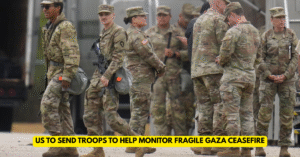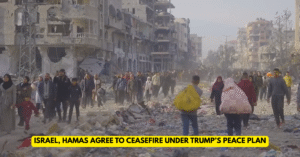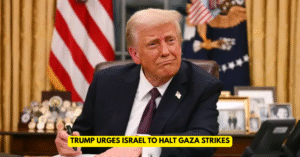NEW YORK — In a surprising turn, U.S. President Donald Trump has suggested that the newly imposed 50% tariff on Indian oil imports could be influencing ongoing Russia-Ukraine peace talks. The announcement marks a significant escalation in Trump’s economic pressure campaign against countries buying Russian oil — with India now at the center of the storm.
Speaking at a press conference in New York, Trump said,
“We put a 50% tariff on India… I don’t know if that had anything to do with it, but we’ve had very productive talks today.”
The remarks came shortly after a three-hour diplomatic meeting between Trump’s special envoy, Steve Witkoff, and Russian President Vladimir Putin, which both sides described as “constructive.”
Details of the Tariff and Its Timing
The new 50% tariff, set to take effect in 21 days, follows a previous 25% duty announced just last week, marking a swift escalation in Trump’s trade policy. Though framed as a strategic move tied to the war in Ukraine, the tariffs also reflect a broader “America First” trade agenda that Trump has long championed.
Officials in Washington hinted that the tariffs are aimed at undermining Russia’s energy revenues by dissuading major buyers like India. However, Trump also acknowledged the indirect diplomatic ripple effects, saying that recent developments in the peace process “may or may not” be connected.
India Calls Tariffs ‘Unfortunate’ and Defends Energy Policy
Reacting to the announcement, India’s Ministry of External Affairs issued a measured but firm response, calling the decision “unfortunate” and reiterating that India’s oil purchases are market-driven, not politically motivated.
“India remains committed to securing affordable energy for its people and maintaining policy independence,” the ministry said.
“Energy security for 1.4 billion citizens cannot be subject to external pressure.”
Sources close to the Indian government say officials are reviewing all options and are expected to engage diplomatically with the U.S. to de-escalate tensions.
Peace Talks Show Signs of Momentum
Trump’s comments followed a high-level diplomatic engagement between U.S. and Russian officials — a meeting that could signal renewed momentum toward a ceasefire or framework agreement in Ukraine.
Trump said there is a “very good chance” that he could soon meet jointly with Ukrainian President Volodymyr Zelensky and Vladimir Putin. While no timeline was announced, the President hinted that preparations for a summit are underway.
The mention of the India tariff in this context suggests that Trump sees economic leverage as a diplomatic tool — linking trade penalties to political outcomes in an increasingly complex global chessboard.
Other Nations May Be Next
Trump did not stop at India. In a veiled warning to China, he noted:
“It may happen… I can’t tell you yet, but I can impose a punitive tariff. We did it with India.”
Analysts believe this signals a possible widening of the tariff strategy, targeting other large economies maintaining energy ties with Moscow.
What’s Next for U.S.-India Relations?
The tariff move places India in a challenging diplomatic position — balancing its energy needs, sovereign trade policy, and long-standing ties with both Russia and the U.S. Experts say the unfolding situation will test the resilience of Indo-American relations, especially as Trump ramps up rhetoric during a critical phase of his administration.
For now, both nations appear headed for a period of economic tension, with geopolitical stakes riding on the outcome of Ukraine peace talks and how global energy markets respond.








